Asus Radeon 9800XT/TVD Review
Asus Radeon 9800XT/TVD
This is the first Asus graphics card we've seen based on an ATi chipset. With a 9800XT chipset, 256MB of RAM and video in/out capability, this is a strong debut.
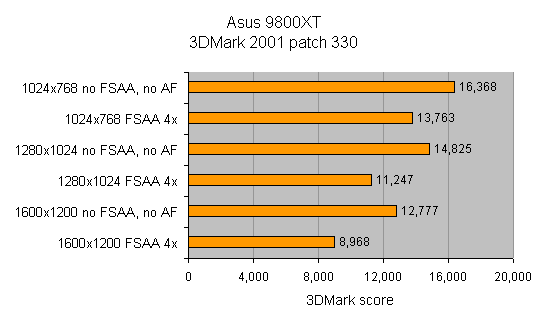
Verdict
Key Specifications
- Review Price: £382.00
Since ATi stole the limelight from nVidia last year with its Radeon 9700, it’s nVidia that has been playing the under dog in the 3D race, a role that ATi was quite happy to relinquish. With the Radeon 9800Pro keeping ATi at the cutting edge this year, nVidia has recently attempted to regain the lead with its GeForce FX5950. But ATi is keeping up the pressure with the release of the Radeon 9800XT. The fact that this retail card is from Asus is a clear indicator of the shift of power in the industry. Asus was formerly an nVidia-only house but the Radeon’s success means that ignoring ATi is no longer an option, even for the big manufacturers. Although this doesn’t mean that Asus won’t be producing cards based on nVidia chipsets as well.
As its name suggests, the 9800XT is a revision of the Radeon 9800Pro rather than a fresh design. The essential differences are an increase in VPU clock speed, up from 380MHz to 412MHz. Memory speeds have been bumped up to 730MHz from the 680MHz sported by the 128MB 9800Pro. All 9800XT cards however, feature a hefty 256MB slice of memory, though it’s DDR1 rather than the hotter running 700Mhz DDR2 used by the 256MB 9800Pros.
The Asus isn’t just a standard 9800XT card though. First, rather than stick with the reference design Asus has opted for a custom heatsink and dual-fan arrangement, which serves to make the card the heaviest I’ve ever held. It makes quite an impression and you’ll at least feel that you’re getting your money’s worth.
Its primary function of the big heatsink is to help overclocking. Although there was no sign of the promised OverDrive facility in the 3.9 Catalyst drivers, Asus supplies its own SmartDoctor utility. Using this, I took the core VPU speed up to 440MHz and the memory up to 770MHz and played Halo extensively without lockups. It’s worth noting that this was done on a system that was itself overclocked, with a 333MHz FSB Athlon XP 2500+ running at 3000+ speeds. This contrasts with the Asus 9600XT, which caused lockups when run in the overclocked system. It seems that the extra power connector that the 9800 series card requires gives it a stability edge when pushing systems to the max.
The SmartDoctor application also enables you to dynamically control the speed of the fans depending on the heat of the GPU detected by a thermal sensor. That said I found the fan noise to be no louder than average.
The second special Asus feature is the inclusion of an integrated Rage Theatre Video chip as used in ATi’s All-inWonder line. A break-out box is supplied with composite and S-Video inputs and outputs for easy hook up. This gives the card VIVO (Video In/Video Out) abilities so you output to a TV or projector or capture video from any source. Asus includes its own Digital VCR software, which though not a patch on ATi’s own Multimedia Centre software, does enable you to capture direct to MPEG2.
The rest of the software is on the unusual side and will have less appeal to most. Video Security enables you monitor the feed from a Web cam, and plays a rather bizarre alarm sound noise as soon as it detects motion. There’s also an app called GameFace, essentially a variant of Netmeeting for viewing a video feed of a friend while playing a game. It’s not something I see catching on.
The rest of the package consists of a game bundle housed smartly in an orange CD holder. There are a number of titles but unfortunately only two are full versions – Gun Metal and Battle Engine Aquila. There is also a voucher for a free copy of next year’s Half-Life 2 – though beware that this is only the single player version.
As you might expect the Asus 9800XT produced some fantastic performance scores, beating the reference GeForceFX 5950 in most tests, if only by a small margin. In 3DMark03, at a resolution of 1,024 x 768, it hit a score of 6024 to the 5950’s 5912. In Unreal Tournament at 1,600 x 1,200 with 4x anti-aliasing and 4x anisotropic filtering enabled it won out with 75.2fps over the 5950’s 70.2fps. Only in GunMetal did the 5950 pull ahead, with 25fps compared to the 9800XT’s 22.7fps. However, as this was developed using CG, the nVidia programming language, and uses version 1.1 DX9 Pixel Shaders rather than 2.0, the game does play to GeForceFX’s strengths.
The Asus 9800XT is a well constructed card that particularly thrives at high resolutions. Playing a game such as Halo with one of these in your rig is a truly incredible gaming experience. Unfortunately it’s one that you’ll need to find a serious amount of cash to gain access to. But if you’re after VIVO features, decent overclocking ability, and you can afford it, the Asus is worth investing in.
”’Verdict”’
An awesome graphics monster. Dual fans provide effective cooling and decent overclocking potential, while VIVO features help it stand out from the crowd. If you don’t need these however, there are cheaper 9800XT cards available.

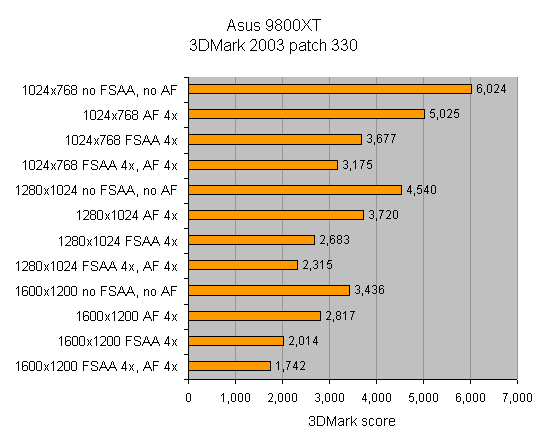
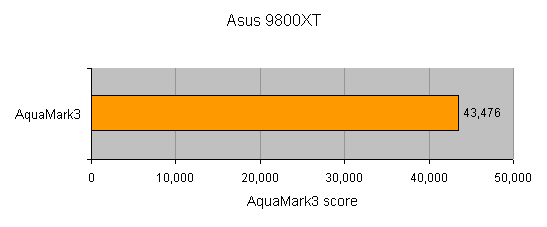
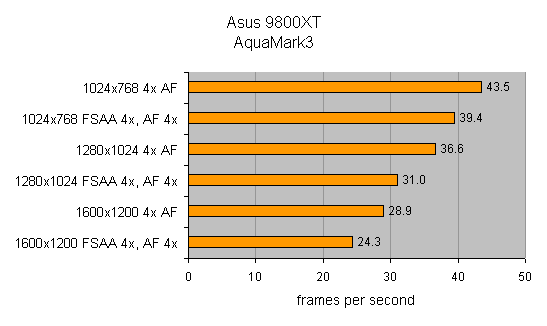
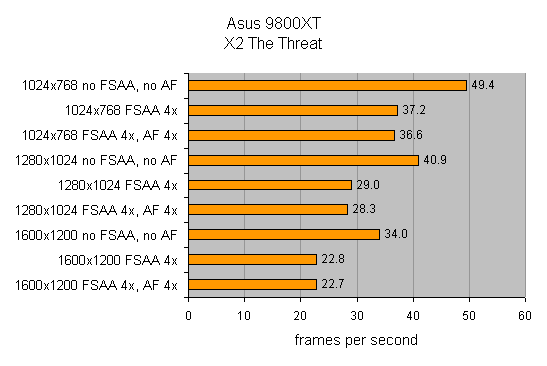
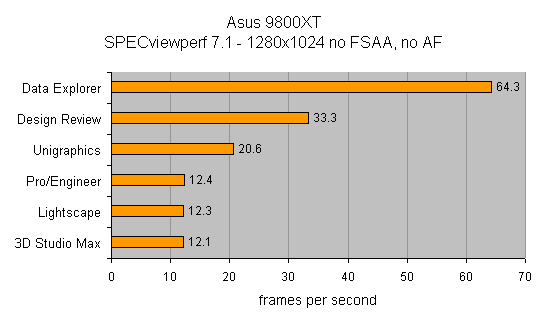
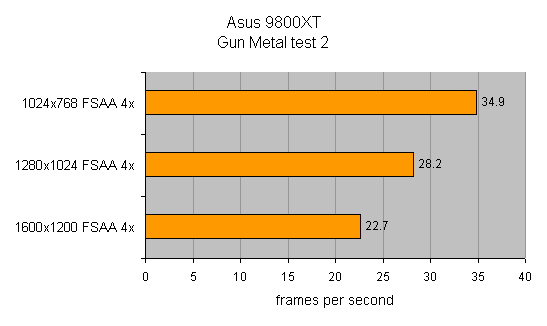
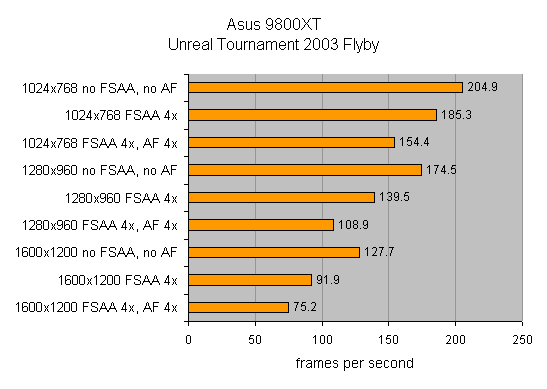
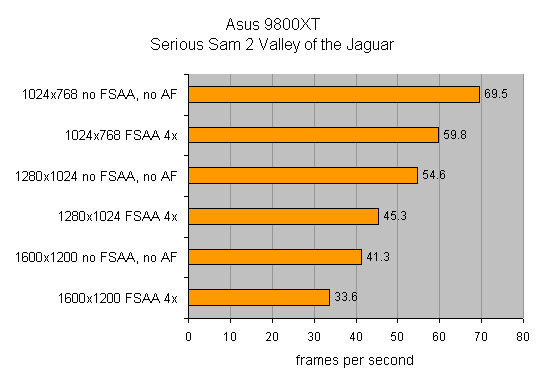
Trusted Score
Score in detail
-
Value 7
-
Features 8
-
Performance 10

